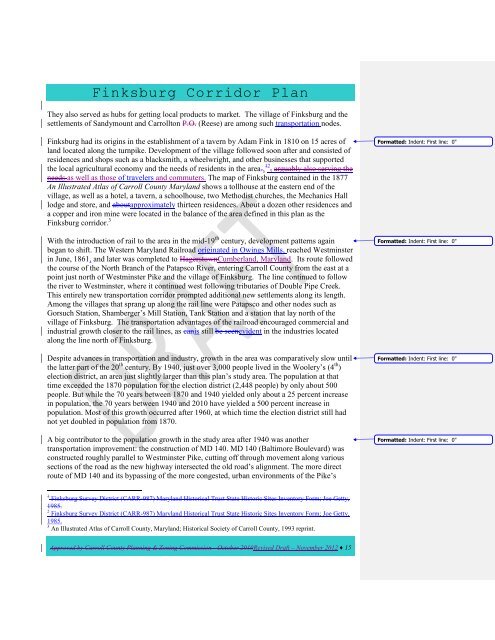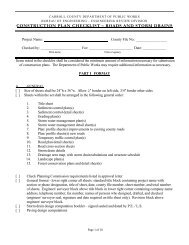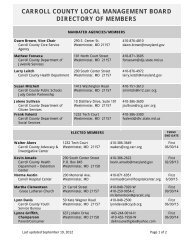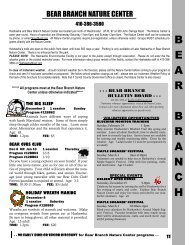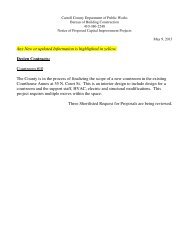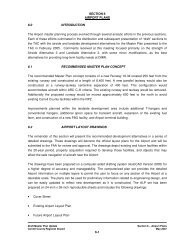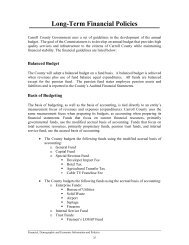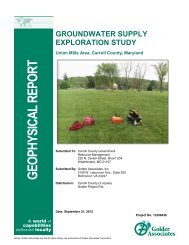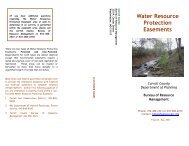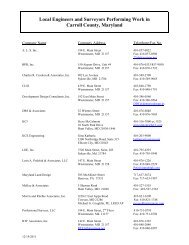Finksburg Corridor Plan - Carroll County Government
Finksburg Corridor Plan - Carroll County Government
Finksburg Corridor Plan - Carroll County Government
Create successful ePaper yourself
Turn your PDF publications into a flip-book with our unique Google optimized e-Paper software.
<strong>Finksburg</strong> <strong>Corridor</strong> <strong>Plan</strong><br />
They also served as hubs for getting local products to market. The village of <strong>Finksburg</strong> and the<br />
settlements of Sandymount and <strong>Carroll</strong>ton P.O. (Reese) are among such transportation nodes.<br />
<strong>Finksburg</strong> had its origins in the establishment of a tavern by Adam Fink in 1810 on 15 acres of<br />
land located along the turnpike. Development of the village followed soon after and consisted of<br />
residences and shops such as a blacksmith, a wheelwright, and other businesses that supported<br />
the local agricultural economy and the needs of residents in the area., 12 , arguably also serving the<br />
needs as well as those of travelers and commuters. The map of <strong>Finksburg</strong> contained in the 1877<br />
An Illustrated Atlas of <strong>Carroll</strong> <strong>County</strong> Maryland shows a tollhouse at the eastern end of the<br />
village, as well as a hotel, a tavern, a schoolhouse, two Methodist churches, the Mechanics Hall<br />
lodge and store, and aboutapproximately thirteen residences. About a dozen other residences and<br />
a copper and iron mine were located in the balance of the area defined in this plan as the<br />
<strong>Finksburg</strong> corridor. 3<br />
With the introduction of rail to the area in the mid-19 th century, development patterns again<br />
began to shift. The Western Maryland Railroad originated in Owings Mills, reached Westminster<br />
in June, 1861, and later was completed to HagerstownCumberland, Maryland. Its route followed<br />
the course of the North Branch of the Patapsco River, entering <strong>Carroll</strong> <strong>County</strong> from the east at a<br />
point just north of Westminster Pike and the village of <strong>Finksburg</strong>. The line continued to follow<br />
the river to Westminster, where it continued west following tributaries of Double Pipe Creek.<br />
This entirely new transportation corridor prompted additional new settlements along its length.<br />
Among the villages that sprang up along the rail line were Patapsco and other nodes such as<br />
Gorsuch Station, Shamberger’s Mill Station, Tank Station and a station that lay north of the<br />
village of <strong>Finksburg</strong>. The transportation advantages of the railroad encouraged commercial and<br />
industrial growth closer to the rail lines, as canis still be seenevident in the industries located<br />
along the line north of <strong>Finksburg</strong>.<br />
Despite advances in transportation and industry, growth in the area was comparatively slow until<br />
the latter part of the 20 th century. By 1940, just over 3,000 people lived in the Woolery’s (4 th )<br />
election district, an area just slightly larger than this plan’s study area. The population at that<br />
time exceeded the 1870 population for the election district (2,448 people) by only about 500<br />
people. But while the 70 years between 1870 and 1940 yielded only about a 25 percent increase<br />
in population, the 70 years between 1940 and 2010 have yielded a 500 percent increase in<br />
population. Most of this growth occurred after 1960, at which time the election district still had<br />
not yet doubled in population from 1870.<br />
A big contributor to the population growth in the study area after 1940 was another<br />
transportation improvement: the construction of MD 140. MD 140 (Baltimore Boulevard) was<br />
constructed roughly parallel to Westminster Pike, cutting off through movement along various<br />
sections of the road as the new highway intersected the old road’s alignment. The more direct<br />
route of MD 140 and its bypassing of the more congested, urban environments of the Pike’s<br />
1<br />
<strong>Finksburg</strong> Survey District (CARR-987) Maryland Historical Trust State Historic Sites Inventory Form; Joe Getty,<br />
1985.<br />
2<br />
<strong>Finksburg</strong> Survey District (CARR-987) Maryland Historical Trust State Historic Sites Inventory Form; Joe Getty,<br />
1985.<br />
3<br />
An Illustrated Atlas of <strong>Carroll</strong> <strong>County</strong>, Maryland; Historical Society of <strong>Carroll</strong> <strong>County</strong>, 1993 reprint.<br />
Approved by <strong>Carroll</strong> <strong>County</strong> <strong>Plan</strong>ning & Zoning Commission - October 2010Revised Draft – November 2012 ♦ 15<br />
Formatted: Indent: First line: 0"<br />
Formatted: Indent: First line: 0"<br />
Formatted: Indent: First line: 0"<br />
Formatted: Indent: First line: 0"


